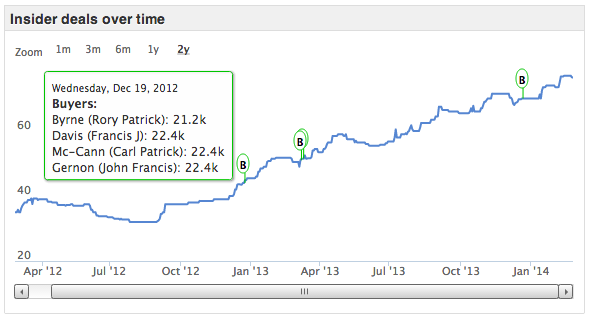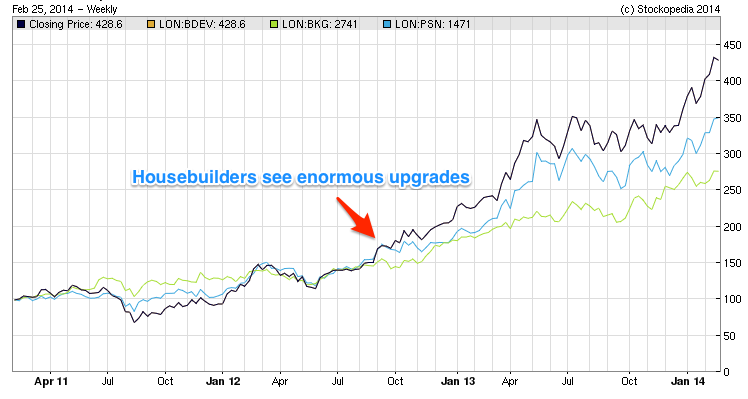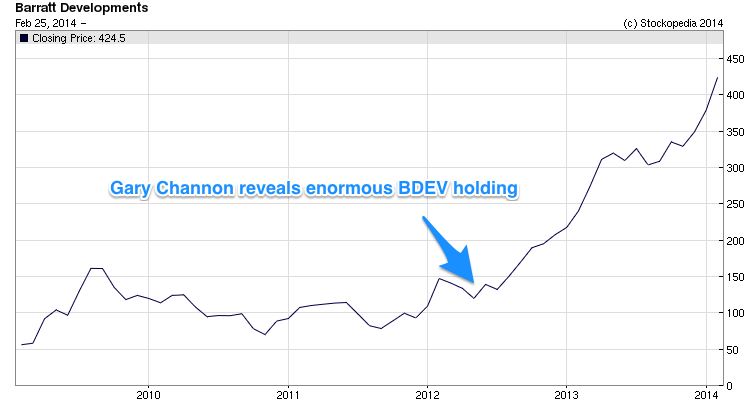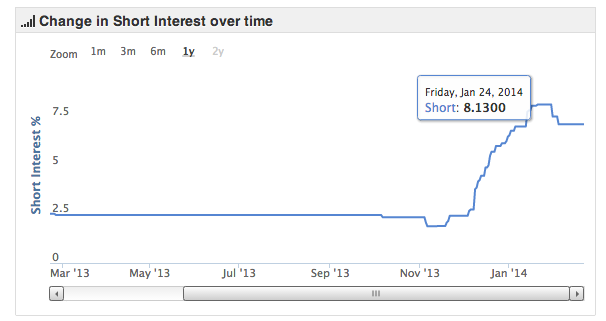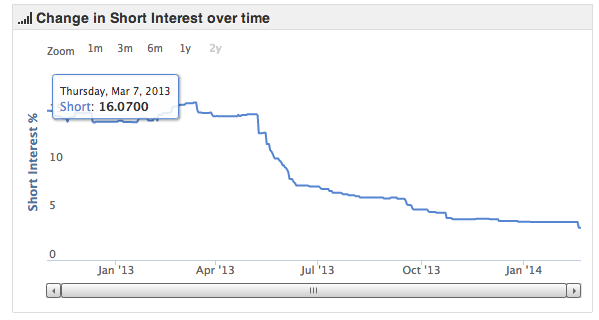Table of Contents
Introduction
Who are the smartest stock pickers of them all? Over time the wealthiest men of all have either been those who have invested in their own businesses from the ground up, or those who have consistently picked the best stocks. Clearly, Bill Gates and Warren Buffett spring to mind as standout examples, but they are just the tip of the iceberg.
There are thousands upon thousands of company insiders and institutional money managers making intelligent decisions day in and day out. These professionals spend all of their working lives considering how to allocate their capital as profitably as they possibly can. How on earth can we, as individual investors, hope to compete?
Well the good news is that we don’t need to compete - we can instead learn to read the signals these investors leave behind and change the rules of the game.
In this guide we define the ‘Smart Money’ as Company Executives, Institutional Fund Managers and their Research Analyst advisors. Their powerful forecasting abilities and intimate access to corporate information are beyond the reach of most individuals. Yet the tell-tale signs of what those closest to companies really think are left in the trail of their actions, holdings, trades and announcements.
Years of academic research have found smart money signals to be excellent at predicting future share returns, yet most of them are ignored. Studies have found that investors often make poor investment decisions by misunderstanding director dealings, institutional holdings and broker research.
We’ve spent countless hours analysing these research papers from sources far and wide and summarised the conclusions in the following chapters. Here’s a taster of just a few of the key findings:
- Portfolios constructed using the top 25% highest conviction positions held by fund managers return beyond 23% per year.
- When more than three directors in the past three months have bought shares in their own companies, returns on average are 2% per month higher than the market.
- Analysis of UK insider dealings activity between 1994 and 2006 found that combining director buying signals with a value and momentum strategy produced an annualised return of 23.5%.
- Stocks which beat analysts’ earnings and sales forecasts have been found to outperform the market by 5.3% over the subsequent six months.
- When short sellers are being ‘squeezed’ and the level of short selling interest in a stock is falling, it can be a sign that its outlook is improving and the price may rally hard.
In the following chapters we’ve explored the most important signals sent out by company insiders, institutional fund managers, short sellers and research analysts. By understanding precisely how, when and why these players trade shares it’s not only possible to piggyback their ideas but actually invest more effectively than they can. With powerful information at hand, private investors can move quicker and more decisively than cumbersome multi-million pound funds and even take advantage when smart money investors don’t see eye to eye.
We hope you enjoy this guide and can put our findings to work. Safe investing!
How to profit from boardroom buying and selling
Whenever you approach the stock market it’s worth considering that the guy on the other side of the trade may be better informed than you are. When you’re buying, he’s selling, when you’re selling, he’s buying. One of you has to be wrong.
While regulators work hard to ensure that price sensitive information about stocks is fairly disclosed, there are still plenty of individuals with a huge information advantage. Without question, those with the most intimate knowledge of a company’s future prospects are its ‘insiders’ - the directors and officers who run it on a daily basis.
What works in director dealings?
In his excellent book The Zulu Principle, celebrated growth stock investor Jim Slater, stressed:
“Particular note should be taken of buying by the chief executive and finance director. They ought to know exactly what is happening within the business and it is always encouraging to see them put their money where their mouth is.”
Studies suggest that simple strategies that buy stocks after director share purchases can beat the market by anywhere between 5% and 10% annually. The catch is that a pure ‘insider tracking’ strategy can lead to quite lumpy profits. Sometimes a strategy like this can under-perform for a couple of years before outperforming again - and not many people can handle that.
So the trick is to use insider trading signals as a confirming factor. Some of the world’s most successful specialist hedge funds copycat director trading signals as part of diversified trading strategies. One study noted that combining director buying signals in cheap stocks with moving share prices (a Value & Momentum strategy) significantly boosted profits to a total of 23.5% annually1.
There have been reams of academic studies since the the 1960s which have aimed to figure out precisely how best to profit from insider trades. While information on director dealings is widely available, not all purchases are meaningful. It’s essential to know precisely how to read them. We have distilled the best of them into a set of 6 Key Rules.
Rule 1: Buy signals tell you more than sell signals
Many investors become terrified when they see a director selling shares. But the fact is that insider ‘sells’ are often made for personal reasons rather than concerns for the company’s prospects. The reasons may be as simple as buying a house, diversifying wealth or payment of tax. Selling can also coincide with the exercising of vested share options, which are often tied to long term incentive and remuneration plans.
So generally the link between directors’ sales and lower future returns on a per-stock basis is fairly weak, except when stocks are on very high valuations. By contrast, insider purchases have widespread predictive value… especially when used in unison with Rule 2. In his best-selling book One Up on Wall Street, ex-Fidelity star fund manager Peter Lynch, explained:
“Insiders might sell their shares for any number of reasons, but they buy them for only one: they think the price will rise.”
UK-focused research has found that company directors often trade in a contrarian fashion2. This means that they are particularly good at buying stocks when the market is undervaluing them and selling when those stocks become expensive. Buying signals in smaller, value shares have been shown to be particularly strong indicators of future price movement, with positive returns carrying on for up to two years after the trade.
Rule 2: Focus on intensive buying by multiple directors
One of the most important patterns in director dealings is cluster buying, or those periods when several directors are snapping up stock at the same time. When more than three directors in the previous three months have bought a stock, returns on average are 2% per month higher than the market. These conviction trades are some of the best at predicting share price outperformance.
They also dramatically reduce the risk of misinterpreting ad hoc buying and selling by directors that may otherwise mean very little. Analysis of cluster buying has found that the higher the number of net purchases by multiple directors over the past three months, the more profitable those trades will tend to be for the directors involved3.
There are various ways to calculate the buying intensity. Some use the ‘Net purchase ratio’ which is the difference between buys and sells compared to the total. Others simply look for cases where the number of buyers is greater than the number of sellers plus 2. Regardless of technique, buying intensity is the single most important factor in director dealings.
Rule 3: Act on buy signals as quickly as possible
To really gain from insider signals it pays to act very, very quickly after the information is released to the market. While insider trades have been shown to be profitable signals for the first nine months after they are disclosed, on average about half of the profits are made within the first 60 days4 and a quarter are made in the first 10 days. The great advantage for individual investors is that they can trade in small size, seizing on these market inefficiencies in a way that hedge funds can’t.
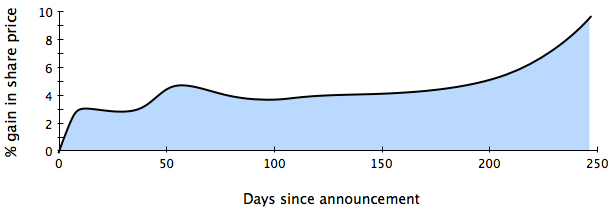
Rule 4: It pays to track the directors rather than officers
Meetings of a company’s management board are the only place where the most sensitive information about operations and finances is shared. While all directors are company officers, not all officers are directors. Clearly one would expect that executive director buying (especially the CEO and CFO) is more valuable than other regular officer buying and the data bears this out. Interestingly, shareholders with a 10%+ interest also seem to have more information than officers. So, evidence shows that you should place your bets with the board.
Rule 5: Focus on larger trades in small value stocks
Director purchases have more value when stocks are very cheap, and especially when they are distressed. There are also higher returns achievable from following director dealings in small and micro cap stocks where it’s much harder for hedge funds to deal effectively and in size.
Research by Lakonishok and Lee, who scrutinised one million trades in the period 1975 to 2005, found that director dealings was a particularly strong indicator in small cap value stocks 5. They looked specifically for strong buy and sell signals and found the highest returns were produced when at least three different insiders were trading sizable amounts of stock.
Rule 6: Focus on companies in less cyclical sectors
Some of the worst returns from insider trades occur in companies in cyclical sectors - such as energy and mining. These sectors have profit cycles tied more closely to macro-economic factors. It’s better to focus on director dealings in consumer staples, finance, services and technology stocks. There are almost double the profits to be made trading off director signals in defensive shares (such as food and beverages) than cyclicals (like housing and cars).
Summary : How you can profit from director dealings
While taking a lead from company executives sounds like an intuitive investing strategy, it hits trouble when you realise that not all director dealings tell the same story. For private investors, here are the key factors to focus on:
- Directors that are buying stock rather than selling.
- Clustered purchases by multiple directors.
- Trading by the most senior board members.
- Recent, large trades in small cap value stocks.
Acting quickly to piggyback these significant insider trades can lead to much improved returns. Overall, private investors should be looking for signs of confidence including directors that are making big recent purchases, regular buying activity and multiple top executives increasing their stakes. Incorporating insider activity into a value and momentum strategy can bring standout returns.
Profit from the secret signals in analyst research
Research analysts are regarded as some of the market’s best informed judges of shares. Employed by brokerages and advisory firms to study stocks, interpret news and dispense trading recommendations, they are a vital conduit of information between companies and investors.
Because analysts enjoy close access to company management teams, their opinions, recommendations and earnings forecasts are highly regarded. However, decades of work by academics has found that this advice isn’t always as reliable, accurate or valuable as you might expect. To get the most out of analyst research requires practising the art of reading between the lines.
Beware of Analyst Recommendations
Scouring the market for companies rated ‘STRONG BUY’ among research analysts sounds like a smart investing strategy, but it isn’t. Of all the thousands of stock recommendations made each year, only around 10% ever advise selling a stock. This mighty imbalance indicates that analysts are hugely biased towards making positive recommendations about the companies they cover.
The truth is that analysts are often fundamentally conflicted. On the one hand they are required to produce objective research while on the other the companies they work for often need to keep up genial relationships with management. While ‘chinese walls’ are supposed to separate different parts of investment banks, analysts rarely seek to compromise the work of corporate finance departments who may aim to secure valuable investment banking work.
So while it may be exciting to see a ‘buy’ recommendation on a share of interest, the absolute level of these recommendations can often be meaningless. Indeed, tracking the performance of recommendations to ‘buy’ shows that they don’t outperform those to ‘hold’ and barely outperform those to ‘sell’. This is made incredibly clear in the chart below.
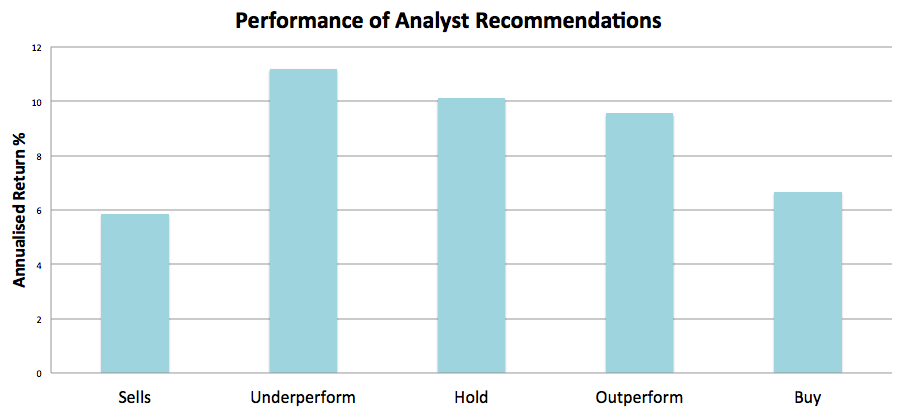
What’s more the predictions they do make tend to lag the market. Here’s a chart from highly regarded GMO fund manager James Montier and a quote that tells a very sad story!
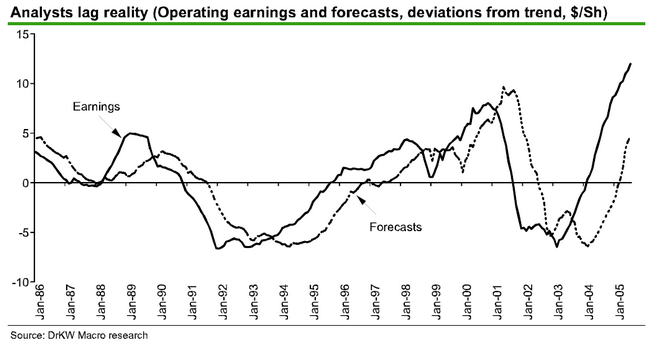
”…analysts are terribly good at telling us what has just happened but of little use in telling us what is going to happen in the future.”
Academics have also found that analysts prefer recommending ‘glamour’ shares.6 These are typically the ‘story’ stocks of the day that boast strong share prices, high growth and high share trading volumes. But these shares can become very expensive to buy. As well-drilled Stockopedia subscribers should know, buying overpriced shares can seriously damage potential future returns7.
So if all this is true how on earth do you read between the lines?
Changes, Changes, Changes…
While analysts are often overly-optimistic, there are still reasons to take note of their opinions. This is because their research is a major contributor to one of the most powerful driving forces behind share prices - momentum.
Price momentum occurs when the market takes days, weeks or even months to properly price a stock to reflect its improved outlook. Traders and fund managers are often slow to react to new analyst coverage or simply can’t work out which analysts are best at spotting mispriced stocks. As a result the stock gradually drifts upwards in price, creating a buying opportunity for momentum investors.
This type of pricing inefficiency is most striking when analysts make or have to make changes. Changes to their recommendations, upgrades to their forecasts or are surprised by company performance.
For investors wanting to capitalise on the momentum effects driven by changing analyst sentiment, there are 3 Key Rules to remember:
Rule 1. Wait for recommendation changes
While analyst buy recommendations barely outperform their sells but it would be a mistake to throw the baby out with the bathwater. When a respected analyst announces a big recommendation change it can create a big shift in the share price on the day of the announcement and often an ongoing share price drift8.
When assessing changes of sentiment in analyst research, it’s important to distinguish between bold revisions and herding revisions. Bold revisions are made by analysts whose recommendation moves away from the consensus view of other analysts - signalling that they have new information. Herding revisions are those that merely move closer towards the consensus - signalling that they simply agree with other analysts. Analysts watch each other’s recommendations closely, seeking job safety by never straying too far from the herd. An analyst rarely puts their career on the line for a bold recommendation, so when they do it’s worth taking note.
Research shows that bold revisions can have a greater initial impact on prices, though the ongoing price drift is driven by the herding revisions. The most powerful boosts are seen in shares that are attracting the highest number of revised recommendations in recent weeks. These recommendation changes can be even more useful when combined with earnings estimate revisions (see Rule 2).

|
A cautionary taleAs a naive young stockbroker at Goldman Sachs, one of my favourite US technology small caps CBT Group suddenly fell by 50% in a day without any reason. I’d been trained to call the analyst in these situations who reiterated his strong buy stance with an assured composure. Trusting in his expertise we put all our clients into the stock only to see it tumble by another 50% the next day on a bad news announcement. Lessons learned - don’t trust analyst recommendations, do your own research, and don’t fight the tape! |
Rule 2. Join the trend in earnings revisions
Earnings estimate revisions are the most powerful force impacting stock prices. Leonard Zacks, Zacks Investment Research
Nothing speaks more about the confidence of analysts than when they make upgrades to their earnings estimates for a stock. Changes to earnings estimates occur much more frequently than recommendation changes. With companies making regular trading announcements to the market, forecasts can be revised on a quarterly or even monthly basis.
A pan-European study into the impact of ‘Earnings Revisions’ found that stocks with the greatest number of upward revisions, net of downward revisions, achieved much higher returns than otherwise similar stocks 9. A portfolio of shares in the highest 20% of net upward revisions outperformed the bottom 20% of upward revisions by more than 16% annually.
Importantly, this work confirmed that positive price momentum can be caused by analyst research. While earnings downgrades were very quickly priced-in by the market, investors were more cautious about upward revisions, knowing that analysts can be biased and over-optimistic. Because earnings revisions can take several months to be fully acknowledged by the market, investors have ample time to take advantage of them.
Rule 3. Act quickly on Earnings Surprises
Expectations of a stock’s financial performance are judged against the earnings per share (EPS) forecasts set by the consensus of analysts. Beating these expectations on results day is a sure fire way for companies to get a warm reception from shareholders. During results season it’s no surprise to see shares jumping 10% or more on the announcement of an ‘earnings surprise’.
Stocks that pull off surprises regularly see their prices drift higher for up to three months after reporting their results. This ‘post earnings announcement drift’ in share prices has been a startling discovery to academics. The publication of reams of research papers has led to many hedge funds basing their entire trading strategies on the anomaly.
In one study, the top 20% of shares in terms of upside earnings surprises outperformed the broader market by 3% over six months and the top 20% in terms of sales surprises outperformed by 2.6%. But a cross sample of the two together managed to outperform the market by an even more impressive 5.3% 10.
Why do shares continue to drift after earnings surprises?
An immediate jump in the price of a share following an earnings surprise can temporarily deter new investors from buying it. Both private investors and institutions can be very slow to react to new information as they come to terms with the idea of buying the share at a new high price. Meanwhile analysts often take as long as six months to incorporate earnings and revenue surprises into their models, leading to delays in new capital allocation.
For those in the know, the tardy response of institutional investors to earnings surprises provides a highly effective trading opportunity for individual investors who understand the power of the ‘earnings surprise’. For instance, Richard Driehaus, one of the world’s most respected momentum investors, puts major emphasis on earnings growth and specifically looks for surprises as a ‘buy’ signal in his strategy. A glance at the performance of a portfolio based on his approach, as tracked by Stockopedia, reveals how successful it can be.
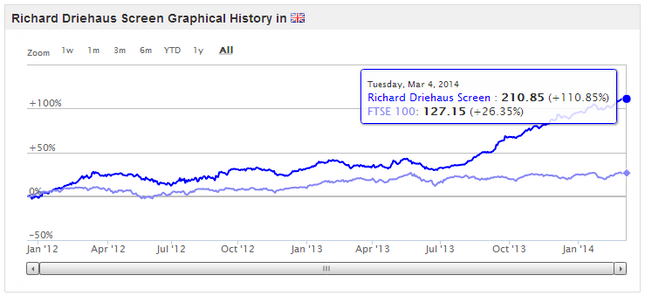
Investors should also be aware of the potential for earnings surprises to become a regular habit for some companies. Those that positively surprise the market with better than expected earnings in the past are more likely to do so again in the future. Meanwhile, serial disappointers are more likely to keep missing expectations 11. This kind of regularity means that earnings surprises are a driver of both earnings momentum and price momentum, which together are one of the stock market’s most potent forces.
Summary - Analysing the analysts
Analysts are undoubtedly some of the smartest thinkers in the City, with the huge advantage of having close contact with company management. Even so, deficiencies in the way research is produced and questions about its objectivity mean that investors must use it with care.
Fortunately, decades of scrutiny have revealed precisely where analyst research is at its most powerful. Typically this is when analysts - either alone or together - revise their recommendations or forecasts or when a company surprises the market with financial results that beat expectations. Studies have shown that it’s in these situations that share prices respond most significantly.
It’s essential to recognise that the market can be surprisingly slow to digest the full meaning of revised expectations and changes of opinion. This uncertainty about how important an upgraded recommendation or forecast really is means it can take many months for share prices to incorporate the change in sentiment. This positive momentum - where stocks that have recently risen often continue to rise in price - is not only proven and predictable but is also one of the most powerful drivers of future share gains in the market.
Overall, the key takeaway from the research into the influence of analysts is that investors must read between the lines. Analysts are regularly poor at predicting price movements. To profit from their expertise it’s necessary to ignore most of their recommendations and focus on the trends in sentiment that can trigger long term price rises.
Why buy funds when you can buy their best ideas?
Institutional fund managers should be some of the smartest stock pickers in the market yet they’re often criticised for failing to outperform their benchmarks. With the level of underperformance averaging around 3% per year, it’s understandable why many investors have become disillusioned with expensive managed funds.
In the words of celebrated growth investor Peter Lynch, himself a once hugely successful fund manager at Fidelity:
“All the time and effort people devote to picking the right fund, the hot hand, the great manager have, in most cases, led to no advantage.”
But if you look beyond some of the high costs that damage fund returns, it’s actually possible to find some of the most highly skilled stock picking around. Even better, if you are looking for standout stock picking ideas, fund manager portfolios are some of the best places to hunt.
How can individual investors copy institutional trades?
In many countries fund managers are forced to disclose their holdings data to financial regulators, while in others such as the UK shareholdings are often on record with registrars. In the US all holdings valued over $250,000 are required to be publicly reported by funds on a delayed quarterly basis using the ‘13-F’ disclosure form. These regulations are supposed to encourage transparency in financial markets and lower the incidence of fraud and manipulation of stocks.
Of course, with greater disclosure comes the increased ability of smaller investors to copy their best trades. And there’s plenty of evidence that copying high conviction fund manager trades can generate impressive levels of outperformance.
The difficulty is often just getting hold of the data. While in the USA the data is often available on free websites, in the UK and internationally it’s much harder to get hold of. Luckily at Stockopedia we’ve come up with a great solution that gives access to global holdings data.
So what are the best stocks in institutional portfolios?
For the canny individual investor, there are 5 Key Rules to separate the wheat from the chaff amongst institutional holdings:
Rule 1. Zero in on a fund manager’s best ideas
As mentioned, fund managers are actually much better stock pickers than the average numbers suggest. By looking closely at the position sizes in a fund, it’s possible to discover the fund manager’s very highest conviction ideas. There is a catch though.
One might expect the best ideas to be the manager’s top 10 holdings by weight, but this would be naive. Because fund performance is usually assessed against a benchmark (like the FTSE 100), a cautious manager fearing for his career may well weight his portfolio similarly. This ensures that the fund performance won’t diverge so far from the index that investors flee.
So it’s only for the very highest conviction ideas that a fund manager will deviate his portfolio weightings most substantially. Indeed, the stocks that have the very highest deviation away from a benchmark weighting (the tilt) seem to outperform the rest of a fund manager’s picks substantially.
In a ground-breaking 2005 paper that examined this common sense idea12, it was found that portfolios comprising the top 25% highest conviction positions held by fund managers outperformed the market by up to 23% excess annually.
The second, third, fourth and fifth best ideas perform gradually worse. Anything outside the top five best ideas is unlikely to be a high conviction trade and may underperform accordingly.
Given the delay in reporting new holdings, one might be concerned that all the upside would be hard to capture. But individuals have plenty of time to join the party. A simple buy-and-hold portfolio of these ideas continues to outperform month by month for up to 12 months after the portfolio is constructed.
Rule 2. Stick to the boldest, freshest, most unique ideas
Research into institutional best ideas has shown it to be an effective strategy on its own, but there are other components to this top picks approach that can squeeze out additional profits:
- Freshness: Filtering further to find just the conviction holdings that are being bought or added to can increase returns by several percent per year. The newer or ‘fresher’ a stock idea the better.
- Boldness: far greater returns can be generated by focusing on the very highest tilts. The very highest conviction 25% of ideas outperform by up to 23% per year. The bolder the position, the better.
- Uniqueness: Amazingly, the performance of institutional top picks is best when no other fund manager shares a stock as their best idea. This doesn’t get in the way too much though, given that ‘more than 70% of best ideas do not overlap across managers, and only 8% of best ideas overlap over three managers at a time’.
- Risky Picks: Dramatic improvements to profits were found by adjusting the rankings of each stock in the list by its share price volatility versus the benchmark. This makes sense when you realise it’s the job of a fund manager to smooth returns. As a result, overweight positions in risky stocks are highly significant because fund managers will only buy them if they are convinced they have value potential.
Rule 3. Focus on concentrated funds that make big bets
While everyone knows that investment funds often underperform, there is a hidden seam of active funds that can generate alpha by doing things differently. Among them are fund managers that deliberately make big bets on stocks while running concentrated portfolios.
Many big funds own hundreds of stocks, effectively just tracking an index and having very little chance of beating the market. Those funds that are highly focused (in 30 stocks or less) are high conviction funds having a much better chance of outperforming. In 2006, researchers studying fund industry data found that concentrated managers outperformed their more broadly diversified peers by around 4% annualised.13
It turned out that these focused managers excelled because their big bets outperformed the top holdings of more diversified funds. This shows that fund managers who tilt their portfolios in favour of their preferred shares are often better at stock picking and identifying the strengths and weaknesses of companies generally.
Rule 4. Seek ideas shared across multiple funds in one firm
While it seems obvious to investigate individual fund manager ideas, what about the best ideas that get shared across their firms ?
In 2009, Canada-based finance academic Lukasz Pomorski14 investigated whether the common trades of fund managers working at the same firm could continue to beat other trades and the market as a whole. He found that identifying and purchasing the stocks bought across multiple funds at the same firm achieves an outperformance of almost 6% per year.
The research found that these stocks continue to outperform over the next quarter after identification. The effect gets stronger when three or more allied funds trade, and is strongest when at least four funds trade the same stocks.
Stocks that are enjoying improved levels of liquidity tend to attract institutional interest, which pushes up share prices in a reinforcing loop. So the signal here is that while elephants may not gallop, whales move rather slowly as they feed - if you can piggyback a ride on a fund manager’s best ideas it does appear you can make yourself handsomely better off.
Rule 5. Ride the tide of institutional ownership
The number of institutions in a stock generally doesn’t tell you much. But when more and more institutions start clamouring to own a greater percentage of a company’s free float it can create a feeding frenzy and seriously impact the share price.
Work by US academic Nofsinger15 in the late 1990s found that, on average, the 10% of stocks with the largest increase in institutional ownership outperformed the 10% of stocks with the largest decrease by more than 31% per year.
Not everyone agrees about precisely why institutional fund managers influence share prices, but here are some of the most common reasons:
- They can be short-term momentum traders who buy stocks that have risen in price.
- They are adept at forecasting quarterly stock returns and actually lead the market by buying stocks ahead of price movement.
- They are simply better skilled at interpreting stock information and timing their purchases accordingly.
- Their trading in the market conveys information that others copy.
- In stocks where liquidity may be low or the supply of shares constrained, institutional trading can naturally drive prices higher.
In a detailed 2006 study of all these factors16, one of the main conclusions was that fund managers are generally better informed than most other investors. As such, their information becomes priced-in by the market as soon as they trade a stock. Crucially, because information plays such an influential role in fund trading, changes in the actual number of institutions in a stock (regardless of whether they are small or large institutions) seems to be more predictive than changes in the percentage of shares that institutions own.
Is it ethical to copy institutional trades?
A growing array of websites like Stockopedia and ETFs are helping sharp investors to profit as soon as institutional trades are disclosed. Unsurprisingly, fund managers in the US have built a chorus of disapproval.
Some think it unethical for investors to copy expensive institutional research processes without sharing the cost. But individual investors shouldn’t feel guilty. Many fund managers hold large numbers of stocks that have little hope of performing well. These stocks are instead bought for reasons that primarily serve the manager’s own interests rather than those of their investors. Just a few reasons include holding stocks in order to:
- …diversify in order to reduce portfolio volatility and becalm flighty investors.
- …act as a liquidity service for customers that need to redeem their investments.
- …asset gather. The fee based pay structure of the fund management business encourages asset gathering - and those assets have to be invested in something, even if it means they can’t be invested in good ideas.
Summary - How to profit from institutional ownership
Increasing numbers of investors are recognising that the actively managed fund industry generally offers poor value for money as a result of high costs and underwhelming returns. In an industry that’s geared up to making a profit for itself first, and its customers second, these numerous intrinsic failings leave investors with the odds stacked against them.
So why should regular investors be held hostage to the economics of large scale fund management? The answer is that they don’t have to be, but they can still benefit from the experience, expertise and stock picking skill of some of the smartest investors around.
With the best data and tools to hand it’s possible to scrutinise fund portfolios for best ideas, high conviction positions and tell-tale trades that signal a fund manager’s favourite picks. Unusually high tilts in a portfolio, ideas that diverge from other fund managers and heavily weighted positions in small or volatile shares can reveal where the smart money sees alpha.
Not only that but insight can be gained from examining top picks across entire investment management firms, watching fund managers that are prepared to make big bets and recognising when institutions are changing their positions in stocks.
Fund managers have extraordinary insight and are capable of making some hugely well-informed and highly profitable trades… but just not that many of them. By understanding the structural inefficiencies in the industry and recognising where the best ideas and top picks can be found, regular investors have a major opportunity to profit from them.
How to avoid getting caught out by short sellers
For the vast majority of investors, short selling is a discipline that’s at odds with their own investing approach. Most will usually buy shares with the expectation that they’ll rise in price rather than short sell them in the hope they’ll fall. Not only that, but attempting to profit from falling share prices can incur high trading costs and the risk of big financial losses. But some investors, such as hedge funds, specialise in finding shares to short sell, which means they have to be some of the smartest stock pickers around17.
By knowing which shares they are shorting (and how aggressively they are shorting them) you can avoid potentially dangerous stocks, but also profit from rocketing share prices when they get it wrong.
What is short selling?
To sell a stock short, a ‘shorter’ first has to borrow shares from someone who owns them and then sell them into the market. They are now short and will aim to buy the shares back at a lower price to make a profit.
If the stock price rises the short seller will lose money, and because share prices can keep rising there is a theoretical risk of infinite losses. For this reason, short sellers may need very deep pockets, a strong appetite for risk and a long investment horizon before their bets come good. Short selling clearly isn’t a game for widows and orphans!
Borrowing shares generates ongoing costs in the form of interest payments to the lender so the short seller has to be certain that the share price will fall. Generally, it is only institutional investors with large research departments that are able to find the edge needed to be sure their short positions will work.
In an interview with Columbia Business School’s investment newsletter Graham & Doddsville, Jim Chanos, a famous short seller and founder of hedge fund Kynikos Associates, explained:
“You’re basically told that you’re wrong in every way imaginable every day. It takes a certain type of individual to drown that noise and negative reinforcement out and to remind oneself that their work is accurate and what they’re hearing is not.”
Given the conviction needed to be a successful short seller, it’s unsurprising that academic studies have found that heavily shorted stocks do underperform the market by a considerable margin. This is exacerbated when you consider that the act of short selling can itself be a magnet to other short sellers, who join the trade and push the price down further.
How to measure how much shorting is going on in your stocks
While hedge funds generally keep their research a secret from curious onlookers, their short positions must be disclosed to the market regulator by law. In the UK the data is published in an arcane spreadsheet deep on the Financial Conduct Authority’s website. Here, hedge funds are obliged to record changes in their positions on an ongoing basis. From this data shrewd investors can compile several key metrics:
1. Short Interest
If you divide the number of shares being short sold by the number of shares outstanding in a company you can find the level of ‘short interest’ - usually expressed as a percentage. As an example, if 12.5m shares are short sold in a company with 100m shares outstanding, the short interest would be 12.5%.
In the UK market only about 15% of shares are being short sold at any one time and the range of short interest levels can vary between 0% and 15%. In general, the higher the short interest, the more negative the short selling sentiment is about the stock. But there’s no need to be immediately frightened by a stock with short interest of just a few percent. Research shows that stocks with low short interest can often outperform, but high short interest is a major red flag18.
For long-only investors, profiting from short interest data can be a simple as sticking to buying shares with no or low levels of short interest and avoiding shares with high short interest.
2. Days to Cover
Given the potential for infinite losses when stocks rise instead of fall, short sellers really hate being stuck in a position going against them that they can’t unwind. If the share price rises, their losses can escalate to a point where they are forced to buy back shares at a loss. This buying pressure can force other short sellers to unwind too, creating what’s called a ‘short squeeze’. A simple ballpark measure of this short squeeze risk is given by the number of days it would take for all the shorts to unwind (cover) their positions.
The Days to Cover metric is worked out by dividing the number of shorted shares outstanding with the stock’s average daily trading volume. For example if Company X has 10 million shares held short and an average daily trading volume of 2 million - its Days to Cover is 5, meaning that it would take 5 days for all those shorts to be covered.
Analysts use this ratio to measure the sentiment around a stock. The higher the Days to Cover, the more likely it is that short sellers will act to avoid further losses and the more extreme a short squeeze is likely to be.
While short sellers are famously smart sellers, they do occasionally get it wrong and rising prices can be justified. A short squeeze can be the first sign that a company’s fortunes might be changing and that sentiment towards it is warming. For the long-only investor, it can represent a bullish signal and the chance to profit from a likely rally caused by a shake-out that has short sellers running for the exit.
But there is a need for caution. While short sellers can make the wrong call, they can also be the victims of temporarily irrational markets. Be warned: increasingly exuberant markets - as seen since the 2009 stock market crash - can disguise all sorts of ‘nasties’. In these circumstances stock prices can become overstretched as confidence grows and money flows into the market. As a result, junk stocks can become expensive and defy the expectations of short sellers for protracted periods. The question is, when sentiment changes and short sellers are proved right, do you want to be left holding the baby?
How to take short selling signals further
While short interest and Days to Cover are very useful indicators, they don’t always work and sometimes give conflicting signals. As is so often the case with financial metrics, they become even more powerful when used in conjunction with other indicators.
1. Measure how much conviction the shorts really have…
Short interest really only tells you one side of the short selling story, and that’s how much demand there is to short the stock. It doesn’t tell you anything about the supply of shares that are available to short.
The supply of stock available to short sellers can be worked out by measuring how much of it is owned by institutional investors. This is simply because short sellers typically borrow their stock from big institutional owners. Shares become particularly vulnerable to a fall when very high short interest combines with low institutional ownership. Shorting these particular stocks needs strong conviction on the part of short sellers because the tight supply forces up the cost of borrowing them.
Analysis by academic researchers of shares over the period 1988-2002 found that the very highest constrained shares performed particularly badly on a monthly basis20. For long-only investors, these findings have some pretty stark conclusions: namely that they should avoid shares that are being shorted when institutional ownership is low.
2. Measure how complacent the analyst community is…
Like short sellers, research analysts are some of the most informed players in stock market investing, particularly because they have good access to company management.
Yet, surprisingly, there’s evidence that the two sides often reach opposite conclusions from the information available to them. Analysts have a tendency to issue positive notes about the stocks they cover, perhaps as a result of being lured by the prospect of lucrative investment banking work in the future. By contrast, short sellers are entirely bearish about the shares they target and scrutinise fundamentals and valuations carefully before placing bets with client funds.
Work by a team of US researchers in 2010 investigated whether the differing opinions of analysts and short sellers could ever predict which way a share price would move21. Incredibly, the results showed that when a heavily shorted stock was highly rated by analysts, the analysts had made the wrong call. This means it makes sense for investors to sell, short or avoid shares with the best broker recommendations but the highest levels of short interest.
3. Measure the direction of change of the shorts…
In all things stock market related, price momentum is a critical factor. Rapidly rising short interest, as we saw in the Blinkx case study, can highlight serious flaws in a stock which might have been missed by traditional fundamental analysis. On the other side, falling short interest may indicate a stock where the shorts are rushing to unwind their positions, adding to buying pressure and potentially magnifying the reasons for holding your shares.
All of these factors, as well as the volatility of a stock, can be used in conjunction to provide more accurate metrics.
4. Measure how volatile the company’s share price is…
Heavily shorted stocks with relatively high medium- and long-term price volatility (often found with smaller shares) are also more susceptible to the types of large price movements that can cause a short squeeze. In these cases, heavily shorted, highly volatile shares that are experiencing a downward trend in price can periodically see very sharp upward price spikes. These have the potential to panic short sellers out of their trades.22
Summary - How you can profit from short selling signals
With some of the most powerful research to hand, short sellers serve a useful role in finding potentially problematic shares. Their actions can be a useful counter-weight to irrational market confidence that keeps share prices in check. As respected analyst and economist James Montier, observed:
“Short sellers have been vilified pretty much since time immemorial. This has always struck me as strange, the equivalent of punishing the detective rather than the criminal.”
Observing the actions of some of the smartest and best informed investors in the market can offer a substantial edge. In summary:
Rule 1: Stocks being heavily short sold are best avoided by investors. They tend to underperform, especially when there’s also low institutional ownership.
Rule 2: Just a little short interest shouldn’t worry you.
Rule 3: When the brokers say buy, but the shorts don’t agree, it’s worth trusting the shorts.
Rule 4: When short sellers are being ‘squeezed’ and short interest is falling, the company outlook might have improved and the price may rally hard.
While traders with spread betting or CFD accounts have the option of joining short sellers in their battles against the bulls, most investors will benefit from understanding what short data really means. Armed with this knowledge, they can protect themselves from share price falls and profit from short squeezes.
Conclusion - Get Smart !
Enhancing your investment strategy
When we set out to build Stockopedia’s new Smart Money tools, it quickly became clear that we had an immense task on our hands. There was a huge and unwieldy new data set to learn about. Then it had to be developed into tools that our subscribers could use and love. But it wasn’t just a case of plugging in a range of new services. We had to grapple with precisely where the most important nuggets of information were. We had to determine what this data could tell us and how our subscribers could profit from it.
Ultimately, those questions meant looking for research that until now has been the preserve of market professionals. Sure, many of us are already conscious of the actions of smart money investors. We might hang on the words of research analysts, wonder at the buying and selling of company directors and fund managers and be struck by fear of short sellers. Heck, a few of Stockopedia’s screening tools already look for some of these signals. But what we found when we put it all together was a set of smart money signals that are proven to influence share prices. That means they can improve your investment returns.
It starts with a process
At the heart of everything we do at Stockopedia is a belief in sound investment styles based on what actually works in stock markets. The strongest forces influencing share prices are ‘Value’ and ‘Momentum’ - better known as ‘cheapness’ and ‘share price strength’. The prices of stocks, sectors and indices tend to trend in a single direction, but eventually greed or fear ensures that they overshoot. Investing with momentum captures the trend, while investing for value captures or defends against the overshoot.
Academics and traders have shown that a share portfolio built using a blend of these principles has beaten the market over almost all time frames. James O’Shaughnessy, in his famous book “What Works on Wall Street”, showed that a portfolio of Trending Value stocks has been the best performing strategy over the last 40 years. Meanwhile the quants at AQR Capital have published astonishing research titled “Value and Momentum Everywhere” which illustrates the perpetual outperformance of the strategy. Not only does this blended approach outperform, but it does so at almost half the risk of using either strategy alone.
Smart Money boosts profits
So what happens when you add Smart Money to the mix? A classic example of the impact of overlaying Smart Money signals to a sound Value and Momentum strategy was shown in a 2008 research paper titled “Some Insiders Are Indeed Smart Investors”. While the study didn’t include transaction costs it found that further filtering Value and Momentum shares for Insider trades resulted in a 23.7% annualised performance between 1995 and 2008, an astonishing result.
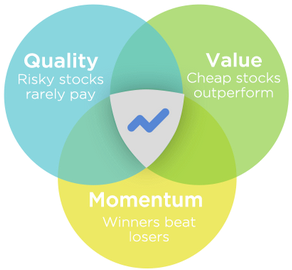
The principles of Value and Momentum make up the core axis of the Stockopedia StockRanks system. By incorporating Quality these systems help guide investors into sound capital allocation decisions. By incorporating confirmatory signals from Smart Money Rankings investors can take these principles even further. Whether you are a ‘hunter’ (stock picker) or a ‘farmer’ (systematic investor) you can build Smart Money signals into your investment routine.
For the stock picking ‘Hunters’
Hunters are much more active in daily stock markets, seeking to invest more nimbly and select individual stocks for their portfolio. If this is your style, try scanning lists of stocks daily or weekly that are showing evidence of insider buying, high conviction fund manager bets or strong earnings momentum. Finding standout quality, cheap, moving stocks that are showing Smart Money backing can be a huge confirmatory signal. Act quickly in these scenarios and you could find a rare market gem.
For the rule based ‘Farmers’
Farmers tend to rely on periodic stock screening to highlight portfolios of shares worth buying. Screens can be built according to sound investment principles but taken further by incorporating Smart Money rankings. The great benefit of using rankings as criteria in screens is that one can discover stocks showing the general, rather than specific signs of Insider, Institutional or Analyst backing. The easy to use Stockopedia Insider Rank, Best Ideas Rank and Earnings Momentum Rank can be added as overlays to a traditional value/momentum screen to filter candidate stocks further.
For illustrations of the application of these principles as well as a variety of ready to go screens please do check out the tools at www.stockopedia.com. We aim to make the best investment processes completely available wherever you are.
Hope to see you online soon!
Ed and Ben
- Giamouridis, Daniel, Manolis Liodakis, and Andrew Moniz. “Some insiders are indeed smart investors.” Available at SSRN 1160305 (2008).↩
- Gregory, Alan, Rajesh Tharyan, and Ian Tonks. “More than just contrarians: insider trading in glamour and value firms.” European Financial Management (2011)↩
- Seyhun, H Nejat. “Insiders’ profits, costs of trading, and market efficiency.” Journal of Financial Economics 16.2 (1986): 189-212.↩
- Leonard Zacks “The Handbook of Equity Market Anomalies” 2011. 25 Feb. 2014↩
- Lakonishok, Josef, and Immoo Lee. “Are insider trades informative?.” Review of financial studies 14.1 (2001): 79-11.↩
- Barber, B. “Can investors profit from the prophets? Analyst recommendations and stock returns” 2010.↩
- Jegadeesh, Narasimhan et al. “Analyzing the analysts: When do recommendations add value?.” The Journal of Finance 59.3 (2004): 1083-1124.↩
- Womack, Kent L. “Do brokerage analysts’ recommendations have investment value?.” The Journal of Finance 51.1 (1996): 137-167.↩
- McKnight, Phillip J, and Steven K Todd. “Analyst forecasts and the cross section of European stock returns.” Financial Markets, Institutions & Instruments 15.5 (2006): 201-224.↩
- Jegadeesh, Narasimhan, and Joshua Livnat. “Revenue surprises and stock returns.” Journal of Accounting and Economics 41.1 (2006): 147-171.↩
- John Shon “Trading on Corporate Earnings News” 2011. 25 Feb. 2014↩
- Cohen, Randy, Christopher Polk, and Bernhard Silli. “Best ideas.” Working paper. Harvard Business School (2010)↩
- Baks, Klass, Jeffrey A Busse, and T Clifton Green. “Fund managers who take big bets: Skilled or overconfident.” Woring paper, Goizueta Business School (2006).↩
- Pomorski, Lukasz. “Acting on the Most Valuable Information:’Best Idea’ Trades of Mutual Fund Managers.” Available at SSRN 1108186 (2009)↩
- Nofsinger, John R, and Richard W Sias. “Herding and feedback trading by institutional and individual investors.” The Journal of Finance 54.6 (1999): 2263-2295.)↩
- Sias, Richard W, Laura T Starks, and Sheridan Titman. “Changes in Institutional Ownership and Stock Returns: Assessment and Methodology*.” The Journal of Business 79.6 (2006): 2869-2910.↩
- Chen, Desai. “A first look at Mutual Funds that use Short Sales” 17th Jan, 2012.↩
- Boehmer, Ekkehart, Zsuzsa R Huszar, and Bradford D Jordan. “The good news in short interest.” Journal of Financial Economics 96.1 (2010): 80-97.↩
- Ben Edelman. “The Darker Side of Blinkx” 2014. 25 Feb. 2014↩
- Asquith, Paul, Parag A Pathak, and Jay R Ritter. “Short interest, institutional ownership, and stock returns.” Journal of Financial Economics 78.2 (2005): 243-276.↩
- Drake, Michael S, Lynn Rees, and Edward P Swanson. “Should investors follow the prophets or the bears?” The Accounting Review 86.1 (2011): 101-130.↩
- Xu, Liu. “Short Squeezes” Aug. 2013.↩

